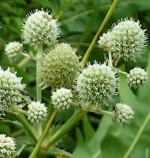 This native of prairies and meadows is one of the odd looking plants that make gardening such fun. It’s yucca-like leaves are spiky, its stems are stout and unbranched except at the tips, and its greenish-white flower heads are stiff and look like small thistles. The flowers appear in summer but last for many weeks afterwards and make excellent cut flowers, fresh or dried. The whole plant has a bluish caste and looks like it belongs in the desert or other dry areas. Used in small groups rattlesnake master is a good addition to a prairie garden or the back of a border. It attracts many bees, butterflies and other insects but larger animals dine only on tender new growth. Rattlesnake master does best in dry, nutrient-poor soil and gets floppy if grown in more fertile soil. Although it is easy to grow from seed, resents being transplanted once it has established its tap root. The common name comes from the erroneous belief of the pioneers that the roots were an effective antidote to rattlesnake bites.
This native of prairies and meadows is one of the odd looking plants that make gardening such fun. It’s yucca-like leaves are spiky, its stems are stout and unbranched except at the tips, and its greenish-white flower heads are stiff and look like small thistles. The flowers appear in summer but last for many weeks afterwards and make excellent cut flowers, fresh or dried. The whole plant has a bluish caste and looks like it belongs in the desert or other dry areas. Used in small groups rattlesnake master is a good addition to a prairie garden or the back of a border. It attracts many bees, butterflies and other insects but larger animals dine only on tender new growth. Rattlesnake master does best in dry, nutrient-poor soil and gets floppy if grown in more fertile soil. Although it is easy to grow from seed, resents being transplanted once it has established its tap root. The common name comes from the erroneous belief of the pioneers that the roots were an effective antidote to rattlesnake bites.
Type: Herbaceous perennial
Bloom: Tiny,greenish white flowers are borne in compact heads in summer. The flower heads are produced in clusters surrounded by greenish white pointed bracts.
Foliage: Basel rosette of sword-shaped leaves have bristly edges and measure up to 3’ long
Size: 1-5’ H x3-3’ W
Light: Full sun
Soil: Nutrient –poor, dry-medium, well-drained; tolerant of a wide range of soils from clay to rocky; drought tolerant
Fertilizer: Fertilizer or fertile soil causes plants to flop
Hardiness: Zones 3-8
Care: Low maintenance but may need staking
Pests and Diseases: None of significance
Propagation: Seed in fall; in spring with cold moist stratification
Companion plants: Smooth blue aster (Aster laevis), (Solidago rigida), wild quinine (Parthenium integrifolium), yellow coneflower (Ratibida pinnata), blazing star (Liatris spp.), Paraire dropseed (Sporobolus heterolepis), Flowering spurge (Euphorbia corollata) , Stiff sunflower (Helianthus rigidus), Culver’s root (Veronicastrum virginicum).
